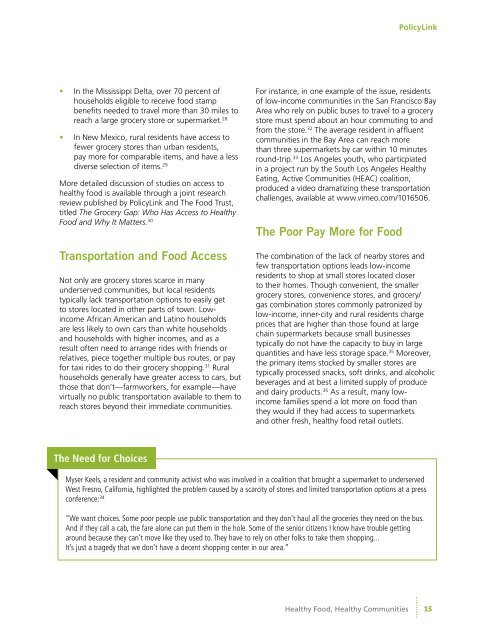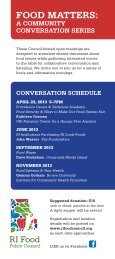Promising Strategies to Improve Access to Fresh, Healthy Food and ...
Promising Strategies to Improve Access to Fresh, Healthy Food and ...
Promising Strategies to Improve Access to Fresh, Healthy Food and ...
You also want an ePaper? Increase the reach of your titles
YUMPU automatically turns print PDFs into web optimized ePapers that Google loves.
PolicyLink• In the Mississippi Delta, over 70 percent ofhouseholds eligible <strong>to</strong> receive food stampbenefits needed <strong>to</strong> travel more than 30 miles <strong>to</strong>reach a large grocery s<strong>to</strong>re or supermarket. 28• In New Mexico, rural residents have access <strong>to</strong>fewer grocery s<strong>to</strong>res than urban residents,pay more for comparable items, <strong>and</strong> have a lessdiverse selection of items. 29More detailed discussion of studies on access <strong>to</strong>healthy food is available through a joint researchreview published by PolicyLink <strong>and</strong> The <strong>Food</strong> Trust,titled The Grocery Gap: Who Has <strong>Access</strong> <strong>to</strong> <strong>Healthy</strong><strong>Food</strong> <strong>and</strong> Why It Matters. 30Transportation <strong>and</strong> <strong>Food</strong> <strong>Access</strong>Not only are grocery s<strong>to</strong>res scarce in manyunderserved communities, but local residentstypically lack transportation options <strong>to</strong> easily get<strong>to</strong> s<strong>to</strong>res located in other parts of <strong>to</strong>wn. LowincomeAfrican American <strong>and</strong> Latino householdsare less likely <strong>to</strong> own cars than white households<strong>and</strong> households with higher incomes, <strong>and</strong> as aresult often need <strong>to</strong> arrange rides with friends orrelatives, piece <strong>to</strong>gether multiple bus routes, or payfor taxi rides <strong>to</strong> do their grocery shopping. 31 Ruralhouseholds generally have greater access <strong>to</strong> cars, butthose that don’t—farmworkers, for example—havevirtually no public transportation available <strong>to</strong> them <strong>to</strong>reach s<strong>to</strong>res beyond their immediate communities.For instance, in one example of the issue, residentsof low-income communities in the San Francisco BayArea who rely on public buses <strong>to</strong> travel <strong>to</strong> a grocerys<strong>to</strong>re must spend about an hour commuting <strong>to</strong> <strong>and</strong>from the s<strong>to</strong>re. 32 The average resident in affluentcommunities in the Bay Area can reach morethan three supermarkets by car within 10 minutesround-trip. 33 Los Angeles youth, who particpiatedin a project run by the South Los Angeles <strong>Healthy</strong>Eating, Active Communities (HEAC) coalition,produced a video dramatizing these transportationchallenges, available at www.vimeo.com/1016506.The Poor Pay More for <strong>Food</strong>The combination of the lack of nearby s<strong>to</strong>res <strong>and</strong>few transportation options leads low-incomeresidents <strong>to</strong> shop at small s<strong>to</strong>res located closer<strong>to</strong> their homes. Though convenient, the smallergrocery s<strong>to</strong>res, convenience s<strong>to</strong>res, <strong>and</strong> grocery/gas combination s<strong>to</strong>res commonly patronized bylow-income, inner-city <strong>and</strong> rural residents chargeprices that are higher than those found at largechain supermarkets because small businessestypically do not have the capacity <strong>to</strong> buy in largequantities <strong>and</strong> have less s<strong>to</strong>rage space. 35 Moreover,the primary items s<strong>to</strong>cked by smaller s<strong>to</strong>res aretypically processed snacks, soft drinks, <strong>and</strong> alcoholicbeverages <strong>and</strong> at best a limited supply of produce<strong>and</strong> dairy products. 36 As a result, many lowincomefamilies spend a lot more on food thanthey would if they had access <strong>to</strong> supermarkets<strong>and</strong> other fresh, healthy food retail outlets.The Need for ChoicesMyser Keels, a resident <strong>and</strong> community activist who was involved in a coalition that brought a supermarket <strong>to</strong> underservedWest Fresno, California, highlighted the problem caused by a scarcity of s<strong>to</strong>res <strong>and</strong> limited transportation options at a pressconference: 34“We want choices. Some poor people use public transportation <strong>and</strong> they don’t haul all the groceries they need on the bus.And if they call a cab, the fare alone can put them in the hole. Some of the senior citizens I know have trouble gettingaround because they can’t move like they used <strong>to</strong>. They have <strong>to</strong> rely on other folks <strong>to</strong> take them shopping...It’s just a tragedy that we don’t have a decent shopping center in our area.”<strong>Healthy</strong> <strong>Food</strong>, <strong>Healthy</strong> Communities15



